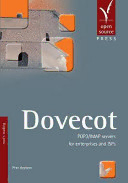
Dovecot: POP3/IMAP Servers for Enterprises and ISPs PDF
Preview Dovecot: POP3/IMAP Servers for Enterprises and ISPs
Dovecot Table of Contents Foreword by Timo Sirainen Preface 1. Protocols and Terms 1.1. An Overview of Terms 1.2. What makes IMAP so complex? I. Dovecot for all purposes 2. Installation 2.1. Installation under Debian/Ubuntu 2.2. Installation under openSUSE/SLES 2.3. Installation under CentOS/RHEL 2.4. Starting Dovecot for the first time 2.5. The first login 3. POP3 and IMAP at protocol level 3.1. POP3 3.1.1. Test-session 3.2. IMAP 3.2.1. Design of the IMAP-protocol 3.2.2. Description of an IMAP session 3.2.3. IMAP in practical terms 3.2.4. Subscribing to IMAP folders 4. Introduction to the configuration 4.1. The doveconf tool 4.2. Where and how to store your local configuration 4.3. Activating log messages 4.4. Specifying the IMAP namespace 4.4.1. The right hierarchy separator 4.4.2. Choosing the folder prefix 4.4.3. Standardized names for trash, sent & Co. 5. Authentication 5.1. Basic settings 5.2. Authentication sources 5.3. /etc/passwd & /etc/shadow 5.4. passwd-file 5.5. LDAP queries/active directory 5.5.1. To begin with: LDAP analysis with ldapsearch 5.5.2. Configuration of password lookups (OpenLDAP) 5.5.3. Configuration of authenticated binds (Active Directory, OpenLDAP) 5.5.4. Setting LDAP search filters for userdb and passdb requests 5.6. SQL databases5.7. Performance optimization: prefetching with LDAP or SQL5.8. Different or identical UIDs?5.9. How not (!) to assign UID, GID and HOME5.10. Saving passwords: plain text or hash? 5.10.1. Authentication methods PLAIN/LOGIN 5.10.2. Authentication methods CRAM/DIGEST 5.10.3. Setting up the CRAM process in Dovecot 5.10.4. PLAIN/LOGIN only secure via SSL/TLS 5.10.5. How password hashes are saved 5.10.6. Login name or email address as login? 5.10.7. Practical suggestion: different userdb and passdb queries! 5.11. Master user5.12. Some extras 5.12.1. Passdb extra fields 5.12.2. Userdb extra fields 5.13. A list of all users – the iterate query 6. How to configure Postfix as a relay in front of Dovecot 6.1. Delivery via dovecot-lda 6.2. Delivery via Dovecot via LMTP 6.3. Configuration 6.4. What recipients are there? Dynamic recipient verification 6.5. Setting up SMTP-Auth in Postfix 6.6. Less is more: do not go via Postfix 6.7. Advanced information on the configuration of Postfix 7. mbox, Maildir and mdbox: a comparison of storage formats 7.1. Overview of the three formats 7.2. Maildir as an email storage format 7.2.1. Technical structure of Maildir 7.2.2. File names of emails 7.2.3. Keywords: custom IMAP flags 7.3. mdbox: the new format for larger setups 7.3.1. Why mdbox is faster 7.3.2. Configuration of mdbox 7.3.3. Making space: doveadm purge 7.3.4. ALT storage: fast and slow data storage combined 7.4. zlib compression on the fly: faster and more space-saving7.5. auto: migration of storage formats during live operation 7.5.1. auto: parallel operation of multiple storage formats 7.5.2. A solid migration script as an example 8. Partitions, file systems and downtimes during the file system check 8.1. /srv/mail as data partition 8.1.1. Email data in a separate subdirectory 8.1.2. Email data on a separate data partition 8.1.3. doveadm mount: in case something is missing 8.2. Choosing the right file system8.3. Measuring performance8.4. Performance tuning the file system 8.4.1. atime 8.4.2. The journal mode in ext3/ext4 8.4.3. Optimized fstab entries 8.5. Out of service thanks to fsckII. Advanced Dovecot Installation
